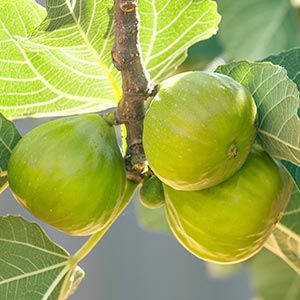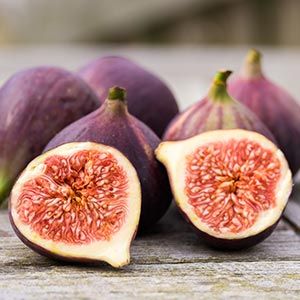Figs: This Chewy Fruit Can Fascinate Your Pet’s Palette
This fruit isn’t the most well-known, but its nutrient profile can pack a punch. If you’re looking to introduce a new treat to your pet, consider this one.

STORY AT-A-GLANCE
- Figs are a unique plant because you can find the blossom inside the fruit itself
- Figs contain various bioactive compounds, such as epicatechin, rutin and gallic acid, which may support pet health in different ways, such as protection against cognitive decline and retention of spatial memory
- If you want to feed figs to your pet, use fresh varieties in small amounts, as these have lower sugar levels compared to dried varieties
Editor's Note: This article is a reprint. It was originally published April 4, 2023.
If you want to introduce new, appetizing fruits for your pet, you may want to try figs (Ficus carica). They’re not exactly the most famous among fruits,1 but they’re just as good as other staples thanks to their diverse array of bioactive compounds and other nutrients. Read on to learn how you can serve figs to your pet, as well as how much you can feed them.
Did You Know?

The fig is one of the earliest plants to be cultivated by humans. From the Levant to the Aegean Sea, this fruit has provided sustenance to numerous cultures throughout the centuries.2
Assorted Bioactive Compounds Flourish in Figs
As mentioned earlier, figs aren’t the most popular fruit sold in the U.S.,3 but that doesn’t mean they aren’t nutritious. In fact, research has discovered that figs contain several bioactive compounds4 that may not only support your health but your pet’s health, too.
One example is epicatechin,5 a flavonol that may help support cognition. One study showed mice that received an increased intake of epicatechin exhibited improved angiogenesis (formation of new blood vessels)6 as well as retention of spatial memory.7
Another notable flavonol found in figs is rutin,8 which offers neuroprotective benefits. Rutin may also protect against hypoxic, glutamate and oxidative stress,9 as well as epilepsy.10 Rutin has anti-inflammatory properties, too, which may benefit arthritic animals, based on mice studies.11 Another bioactive compound found in figs is gallic acid, which may help protect against radiation12 and act as a genoprotective agent.13
Figs Contain Beneficial Vitamins and Minerals
A small fig (around 40 grams) contains 92.8 milligrams of potassium, which may support pet health in several ways.14 In fact, figs are considered to be an important source of this crucial mineral.15 In one animal study, potassium helped lower blood pressure levels.16 It’s also important for proper muscle and nerve function.17 In another example, potassium has been noted to play an important role in renal, gastrointestinal and endocrine systems in cats and dogs.18
Figs are also a good source of magnesium.19 According to a 2021 study, magnesium plays a role in cellular metabolism, bone development and reproduction.20 You’ll find some vitamins in figs as well, namely vitamins K, B6 and riboflavin.21 Vitamin K is essential for proper depositing of calcium into the bones and teeth, as well as helping act as a blood coagulant.22
As for vitamin B6, it’s been found to play a role in red blood cell and nervous system function, hormone regulation, glucose generation and immune system response.23 In the case of riboflavin (also known as vitamin B2), it’s used in the production of red blood cells, energy and antibodies. It also works in conjunction with vitamin A to help maintain the mucous membranes and absorb vitamin B6 in the gut.24
Top Producers of Figs

Market researchers rank Turkey as the world’s top producer of figs. Second place belongs to Egypt, while third place belongs to Morocco.25

Sustainability of Growing Figs
Figs are not included in the Environmental Working Group’s annual Shopper’s Guide to Pesticides in Produce.26 This means that conventionally grown figs are not laden with pesticides and herbicides. However, if possible, still look for spray-free figs from your local farmers market or natural grocer whenever possible.
According to a report from Food Print, figs sold in America generally come from California with the first harvest around mid-summer. Furthermore, fig cultivation isn’t subject to monocropping or other large-scale agricultural practices, so its impact on the environment is considered minimal.27 In fact, experts praise fig trees because they can grow in various conditions around the world, providing biodiversity and sustenance to local fauna. This also makes the fig an ideal candidate for helping regrow forests.28
Figs Fun Fact

One of the most notable oddities of the fig tree is that its branches do not have blossoms. Instead, you’ll find the blossom inside the fruit. Tiny flowers produce the edible seeds inside the fruit, which gives the fig its particular flavor.29
When Offering Figs to Your Pet, Feed Only the Fruit
Misinformation about many healthy fruits, vegetables, nuts and seeds abounds on the internet. This is because websites have labeled all risks (such as the risk of overconsumption causing gastrointestinal issues, or choking on too large of pieces or pits) as "toxicities," which isn't true but has managed to confuse millions of pet lovers, nonetheless.
When it comes to figs, the American Society for the Prevention of Cruelty to Animals (ASPCA) lists the fig plant as toxic to dogs and cats.30 This is because its leaves and sap contain a substance called ficin, which can cause irritation to your pet’s skin, eyes or mouth and is toxic when consumed.31 If you have a fig tree at home, make sure your pet does not have access to it. It’s also wise to familiarize yourself with the symptoms of fig plant poisoning (not the fruit), and seek immediate veterinary care if you suspect your pet has eaten fig leaves and is exhibiting any of the following symptoms:32
- Drooling
- Diarrhea
- Vomiting
- Pawing at the face
- Abdominal pain
- Irritated skin
- Mouth pain
- Watery Eyes
Fortunately, you can easily prevent fig poisoning by offering your pet only the fruit of the fig plant — it does not cause any toxic effects and can impart the beneficial compounds and nutrients discussed above.
Selecting Figs for Your Pet
“When it comes to selecting figs for your pet, pick fresh ones because figs are known to be highly perishable once harvested.”
Furthermore, dried figs tend to have more sugar compared to their fresh counterparts. Fresh figs will also have more vitamins C and A.33 Another reason why you should choose fresh figs is because of the oxalate content in dried varieties, which is much higher.34,35 If your pet is prone to developing urinary oxalate stones, it’s best to feed fresh figs in very small amounts and rotate them with other low-oxalate treats.
Figs are best given as an occasional treat, according to certified canine nutritionist Hannah Zulueta.36 She explained that figs are a natural laxative. They’re rich in insoluble fiber, which may help improve bowel movement. Too much, though, may cause your pet to defecate more than usual.37
Slice the fruit into small pieces (pea-sized) before offering to your pet. You can also offer it in frozen or pureed forms, as an ingredient in a DIY treat. When giving treats to your pet, keep in mind that healthy snacks should only comprise less than 10% of your pet’s daily caloric intake.
Sources and References
- 1,3 International Fresh Produce Association, “Top 20 Fruits and Vegetables Sold in the U.S.”
- 2 Britannica, “Fig”
- 4 Evid Based Complement Alternat Med. 2013; 2013: 974256, Introduction
- 5,8 Agronomy 2021, 11(9), 1834, Abstract
- 6 National Cancer Institute, “Angiogenesis Inhibitors”
- 7 J Neurosci. 2007 May 30; 27(22): 5869–5878, Abstract
- 9 Saudi Pharm J. 2017 Feb; 25(2): 149–164, 2.1 Central Nervous System
- 10 Prog Neuropsychopharmacol Biol Psychiatry. 2014 Oct 3;54:50-8, Abstract
- 11 Saudi Pharm J. 2017 Feb; 25(2): 149–164, 2.2 Analgesic and Antiarthritic Activities
- 12 Biomed Res Int. 2013; 2013: 953079, Abstract
- 13 Environmental Toxicology, September 9, 2020
- 14 USDA, “Figs, raw”
- 15 SFGATE, “Figs and Potassium”
- 16 Trans Am Clin Climatol Assoc. 2015; 126: 46–55, Abstract
- 17 VCA Animal Hospitals, “Hypokalemia (Low Potassium Levels) in Dogs”
- 18 Standards of Care, “Potassium Disorders”
- 19 Nutr Neurosci. 2016 Dec;19(10):475-483
- 20 Nutrients. 2021 Feb; 13(2): 509
- 21 Healthline, “All You Need to Know About Figs”
- 22 Pet Poison, “Vitamin K1 for Dogs”
- 23 American Kennel Club, “7 Vitamins Your Dog Needs for a Healthy Life”
- 24 Total Health Magazine, “Vitamin B2 for Pet Health”
- 25 Helgi Library, “Which Country Produces the Most Figs?”
- 26 EWG, “Shopper’s Guide to Pesticides in Produce”
- 27 Food Print, “Figs”
- 28 Food Unfolded, June 28, 2020
- 29 Valley Fig Growers, “Fascinating Fig Facts”
- 30 ASPCA, Fig
- 31,32 Wag!, “Fig Poisoning in Dogs”
- 33 MedicalNewsToday, “How to Use Figs”
- 34 Sally K. Norton, October 10, 2022
- 35 St Joseph’s Healthcare, “Oxalate in Food”
- 36,37 The Dodo, “Can My Dog Eat Figs Safely?”











